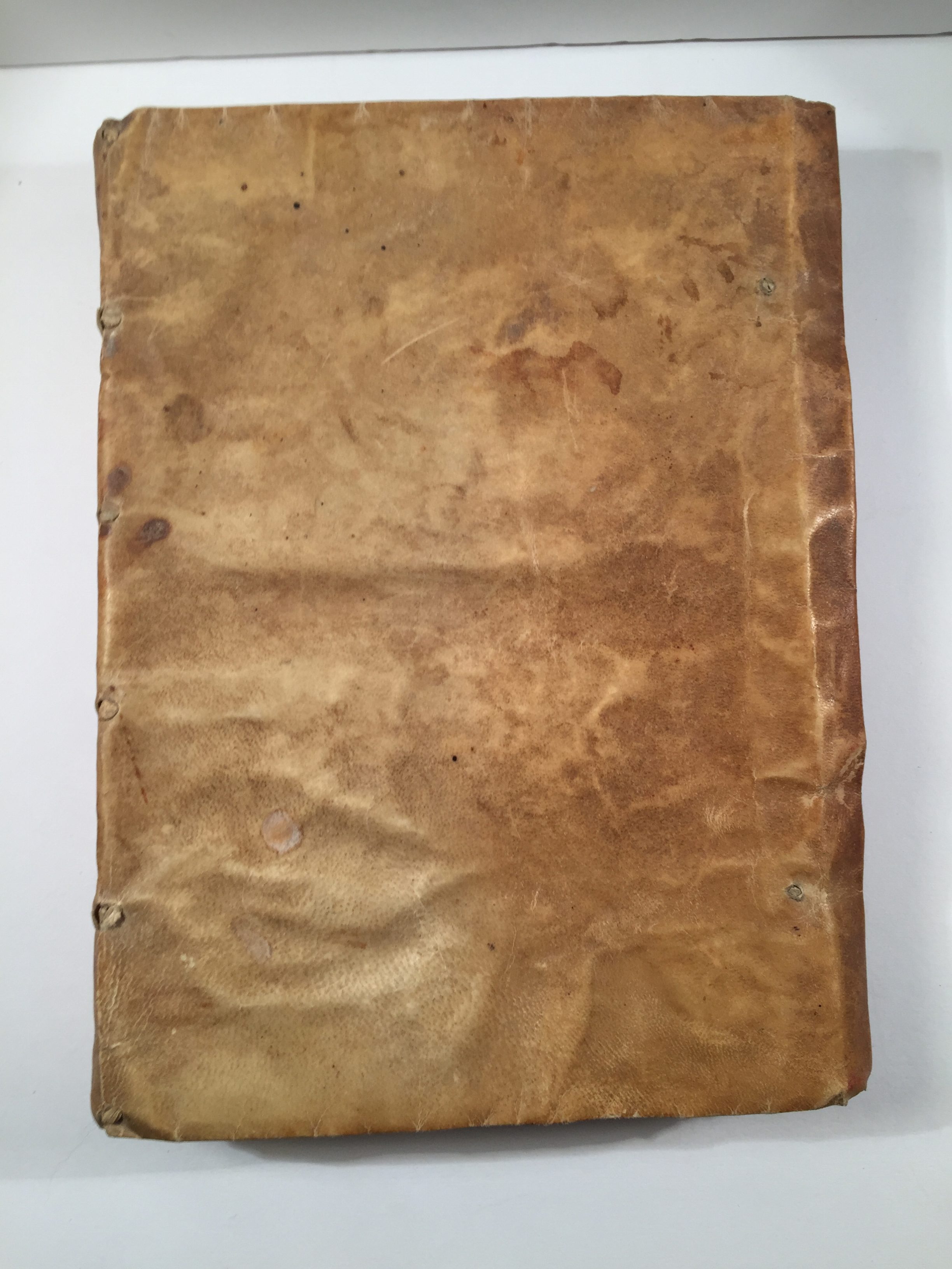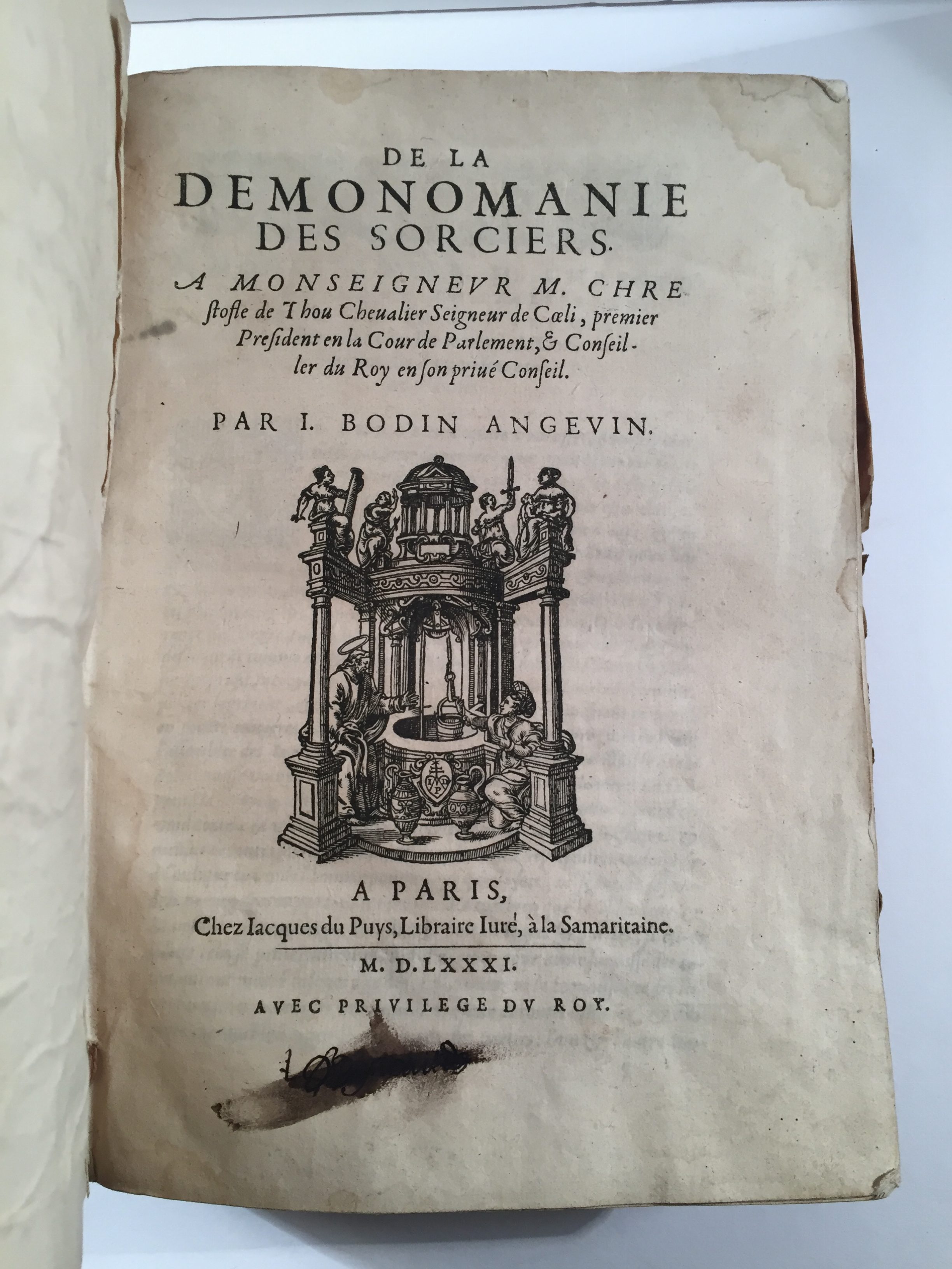BODIN, Jean
De la demonomanie des sorciers
Paris, Chez Iaques de Puys Libraire Iuré, a la Samaritaine, 1581£3,250.00
4to. ff. [xii] 256. ã4, e4, i4, A-Z4, Aa-Zz4, AAa-SSs4. Roman letter, some Italic and Greek. Du Puy’s charming woodcut device on title, floriated and grotesque woodcut and metal-cut initials, woodcut head pieces, large metal-cut tailpiece at colophon, four lines of verse in C18th hand on verso of rear fly, early autograph inked over on t-p. Light age yellowing, small tears on lower outer corner of quire C, original paper flaws, occasional very minor marginal waterstains, marks or spots, tiny worm trail in lower blank margin of quires A and B. A very good copy in contemporary limp vellum, with good margins (some deckle edges in lower margin) yapp edges, remains of ties, vellum a little stained, small hole in spine.
Rare third edition (often misdescribed as second), published a year after the first, of this important, fascinating and most influential treatise on witches by Jean Bodin, which went through five editions by Jaques Du Puy by 1582. “Jean Bodin’s ‘On the Demon-Mania of Witches’ (De la démonomanie des sorciers) appeared in 1580 and rapidly became a major publishing success. It underwent at least twenty-three editions and was translated from its original French into German, Italian and Latin. It was surely the most published work of the era on the subject of demons and witches. Because of its wide distribution, it has been considered by generations of historians to have been an extremely influential book, responsible in itself for large-scale prosecutions of witches in the four or five decades following its appearance.” Jonathan L. Pearl,.”On the Demon-mania of Witches”
Jean Bodin attained eminence as a political philosopher, economist and advocate of religious toleration, and was regarded by most contemporaries as a sceptic or even an atheist, yet he retained an abiding belief in sorcery, astrology and other superstitions. In this work he denounces all who disbelieve in witchcraft and calls for the burning of witches and wizards, although he implies that he himself had for 13 years been guided by a friendly demon who touched one or other of his ears whenever he intended to do right or wrong. He records a number of pacts made with the Devil, as well as alleged sexual relations with lesser demons, and “asserts that witches are transported through the air, that demons assume human form, and that men are transformed into animals. He believes in lycanthropy or werwolves and in the marks of sorcerers. In their professed cures they employ unnatural remedies and poisons like the brain of a cat or head of a raven. Really the only maladies which they can cure are those which they have inflicted, and in this case they must pass the ailment on to someone else…..” (Thorndike VI 526).
“In his many works, Bodin, influenced by Renaissance syncretism and shaken by the extreme violence of his time, was very tolerant of varieties of religious belief. While he generally supported a Catholic settlement of the conflicts, he was far from being an orthodox believer. Generations of scholars have admired the ‘Commonwealth’ as the first modern study of the state and have often depicted Bodin as a modern man. .. But many of these scholars have been shocked and perplexed at the apparent contrast between the ‘modern’, ‘rational’ political Bodin, the ‘tolerant’ religious Bodin, and the intolerant and superstitious Bodin of the Demon-Mania. There is a long tradition among Bodin specialists of either ignoring the Demon-Mania or treating it as a bizarre aberration in an otherwise respectable ‘progressive’ intellectual. .. in fact the Demon-mania shares essential points of view and concerns with the ‘Commonwealth’ and the ‘Colloquium’. Jonathan L. Pearl.
A very good copy of this important work.
USTC. 5913. Index Aurel. 120.819. BM. STC. Fr. C16th p. 72.. Thorndike VI 526. Brunet I 1025: "ce dernier ouvrage a eu une grande vogue dans le temps". Caillet 1269.In stock





